Deborah J. Ross's Blog, page 2
August 15, 2025
Short Book Reviews: A Cozy Battle-Orc Fantasy
Bookshops & Bonedust, by Travis Baldree(Tor)
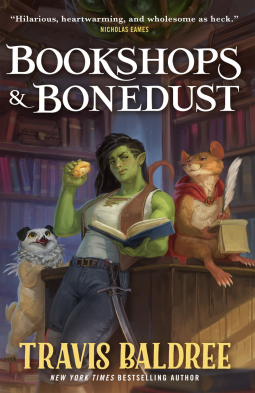
Is there such a thing as a cozy high fantasy with a female battle-orcheroine? Elves, dwarves, enchanted swords, necromancers…and spicy romancenovels? Yes to all of this, because Travis Baldree has invented the subgenre!
Bookshops & Bonedust is a delightful prequel to Legendsand Lattes, although each works beautifully on its own.
Recuperating from wounds incurred in the hunt for a powerfulnecromancer, battle-orc soldier-of-fortune Viv finds herself in the sleepybeach town of Murk with nothing to do. In desperation born of overwhelmingboredom, she follows the literary suggestions of Fern, the ratkin owner of adying bookstore. Any fantasy reader worth their salt knows what comes next! Notonly is Viv drawn into the enchanted world of novels but she sets aboutreviving the bookstore, complete with a surprise appearance by the elf authorof fabled romance adventures. Along the way, Viv encounters a gnome with a chipon her shoulder, a retired mercenary turned baker extraordinaire, a mysterious travelerin gray, and a talking bag of bones. All is not hunky-dory in Murk, however,for the necromancer responsible for Viv’s injury is still on the loose…
I loved every page of it!
August 11, 2025
Reprint: Traumatic Bereavement and How to Help
When grief involves trauma − a social worker explains how to support survivors of the recent floods and other devastating losses
 Rain falls over a makeshift memorial for flood victims along the Guadalupe River on July 13, 2025, in Kerrville, Texas. AP Photo/Eric Gay Liza Barros-Lane,
University of Houston-Downtown
Rain falls over a makeshift memorial for flood victims along the Guadalupe River on July 13, 2025, in Kerrville, Texas. AP Photo/Eric Gay Liza Barros-Lane,
University of Houston-Downtown
The July 4, 2025, floods in Kerr County, Texas, swept away children and entire families, leaving horror in their wake. Days later, flash floods struck Ruidoso, New Mexico, killing three people, including two young children.
These are not just devastating losses. When death is sudden, violent, or when a body is never recovered, grief gets tangled up with trauma.
In these situations, people don’t only grieve the death. They struggle with the terror of how it happened, the unanswered questions and the shock etched into their bodies.
I’m a social work professor, grief researcher and the founder of The Young Widowhood Project, a research initiative aimed at expanding scholarship and public understanding of premature spousal loss.
I was widowed when I was 36. In July 2020, my husband, Brent, went missing after testing a small, flat-bottomed fishing boat called a Jon boat. His body was recovered two days later, but I never saw his remains.
Both my personal loss and professional work have shown me how trauma changes the grieving process and what kind of support actually helps.
To understand how trauma can complicate grief, it’s important to first understand how people typically respond to loss.
Grief isn’t a set of stagesMany people still think of grief through the lens of psychiatrist Dr. Elisabeth Kübler-Ross’ five stages of grief, popularized in the early 1970s: denial, anger, bargaining, depression and acceptance.
But in fact, this model was originally designed for people facing their own deaths, not for mourners. In the absence of accessible grief research in the 1960s, it became a leading framework for understanding the grieving process – even though it wasn’t meant for that.
Despite this misapplication, the stages model has shaped cultural expectations: namely, that grief ends once people reach the “acceptance” stage. But research doesn’t support this idea. Trying to force grief into this model can cause real harm, leaving mourners feeling they’re grieving “wrong.”
In reality, mourning is often lifelong. Most people go through an acute period of overwhelming pain right after the loss. This is usually followed by integrated grief, where the pain softens but the loss is still part of everyday life, returning in waves.
Although grief is unique to each person and relationship, researchers have found that mourners often strive to a) make sense of the death; b) adjust to a world without their loved one; c) form an ongoing connection with their deceased loved one in new ways; and d) figure out who they are without their loved one.
It’s difficult and at times disorienting work, but most people find ways to carry their grief and keep living.
 Julia Mora embraces her granddaughter, Isla Meyer, during a vigil for Texas flood victims on July 11, 2025. AP Photo/Gerald Herbert When grief and trauma collide
Julia Mora embraces her granddaughter, Isla Meyer, during a vigil for Texas flood victims on July 11, 2025. AP Photo/Gerald Herbert When grief and trauma collideHowever, some losses carry an extra layer of pain, confusion and trauma.
Sudden, unexpected, accidental, violent or deeply tragic deaths – like those experienced during the recent floods – can lead to what researchers call traumatic bereavement: grief that is disrupted by the traumatic nature of the death.
People experiencing traumatic bereavement often endure a longer and more intense acute grief period. They may be haunted by disturbing images, nightmares or relentless thoughts about how their loved one died or suffered. Many wrestle with dread, spiritual disorientation and a shattered sense of safety in the world.
Some of these deaths are also considered “ambiguous” – unclear or unconfirmed loss – such as when a body is never recovered or is too damaged to view. Without physical confirmation, mourners often feel stuck in disbelief and helplessness.
This was true in my case. Not seeing my husband’s body left a part of me suspended between knowing and not knowing. I knew he had died but couldn’t fully believe it, no matter how much I lived with the reality of his absence. For a long time, I caught myself repeating these words every morning: “Brent is dead. Brent is dead.”
In many cases, these reactions aren’t short term. Many people affected by traumatic loss remain overwhelmed and sometimes physically and emotionally impaired for years. Symptoms may taper over time, but they rarely disappear entirely.
Supporting mournersTraumatic bereavement can feel unbearable. Many mourners struggle with intense, long-lasting reactions that can leave them feeling helpless, altered or even unrecognizable to themselves. They may appear withdrawn, forgetful or emotionally drained because their systems are overwhelmed. Coping can look messy or self-destructive, but these are often survival strategies, not conscious choices. I’ve also seen how those same struggles become more survivable when mourners don’t have to carry them alone. If you’re supporting someone through traumatic loss, here are three ways to help.
Make space for the horror. Listen without flinching. Acknowledge the full weight of what happened and how terrifying and unjust the loss was. This means saying things like, “This should never have happened,” or “What you went through is beyond words.” It means staying present when the mourner speaks about what haunts them. Let them know they don’t have to carry this alone. You may feel the urge to say something hopeful such as, “At least the body was recovered,” but there is no silver lining in these cases. Instead, say: “There’s nothing I can say to fix this, but I’m not going anywhere.”
Help them find others who can understand. Trauma can be isolating. Mourners often feel uniquely overwhelmed or confused. Support groups, peer companions and therapists trained in treating grief and trauma can offer the kind of recognition and validation that even the most devoted friend may not be able to provide.
Take care of yourself, too. Being present for someone in deep grief takes energy, especially if you were personally affected by the loss. Stay connected to replenishing people, practices and routines. If you don’t, you may begin to experience trauma, too. Taking care of yourself will help you remain grounded so that you can show up.
I believe supporting someone through traumatic bereavement is one of the most meaningful things you can do. You don’t need perfect words or a plan. What sustains them won’t be advice or solutions, but your simple, powerful act of staying.
Liza Barros-Lane, Assistant Professor of Social Work, University of Houston-Downtown
This article is republished from The Conversation under a Creative Commons license. Read the original article.
August 9, 2025
Northlight has a new cover!
Northlight
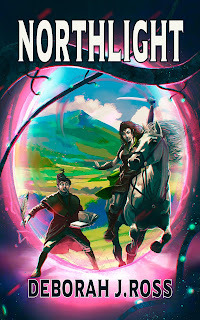
She's a Ranger, a wild and savvyknife-fighter, determined to get help in finding her partner who's lost on thetreacherous northern border. He's a scholar who sees visions, eager to escapethe confines of city life and the shadow of his charismatic mother. With theassassination of a beloved leader and the city in turmoil, the two have onlyeach other to turn to. What begins as a rescue mission turns deadly as togetherthey unravel the secret that lies beneath Laurea's idyllic surface.
Reviews:
"Abeautifully constructed fantasy with characters who grow and mature before thereader's eyes and who are engagingly human while being fantastically heroic.Her writing flows and the point of view switches are interesting and exciting.This book is a keeper." RickeyMallory, Affair de Coeur
"Astyle and manner reminiscent of McCaffrey's Crystal Singer series." TheBookwatch
"Anunusual saga that starts slowly but builds to a startling climax." SherryS. Hoy, Kliatt
"Solidcharacters and a well-designed world make for good reading." PhiladelphiaPress
"Theplot moves briskly from crisis in Laureal to capture by the Norther barbariansto discovery of the true meaning of the Northlight of the title, with ampleforeshadowing from the mysterious spooky something in the air of the frontier.And the culmination quite satisfactorily evokes the sense of wonder." TomEaston, Analog
Amazon: https://tinyurl.com/2czh4mef
Barnes and Noble: https://tinyurl.com/3pvx9cp6
Everywhere else: https://books2read.com/u/3L7GXb
August 8, 2025
Book Review: The Conclusion of the Rook and Rose Trilogy
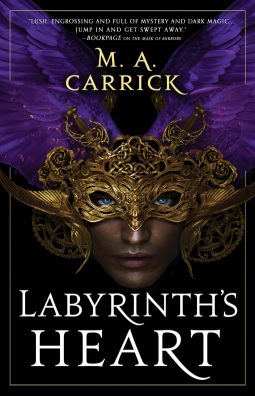 Labyrinth's Heart, by M. A. Carrick (Orbit)
Labyrinth's Heart, by M. A. Carrick (Orbit)Labyrinth's Heart completes the “Rook and Rose”trilogy by M. A. Carrick (in real life, Marie Brennan and Alyc Helms). Thestory began in the Venice-like city of Nadežra with the arrival of con-artistRen, bent on impersonating a long-lost cousin of an aristocratic family andthereby worming her way into rank and riches. An uneasy peace between thenobility and the natives they oppress barely holds in the city. Between theRobin Hood-like Rook (which turns out to be not an individual person but avocation transmitted through a magical mask), gangs tussling for territory, andthe mind-controlling medallions left over from “the Tyrant,” Ren soon findsherself acting several, mutually incompatible roles. One of them, by the way,is a reader of special tarot-like cards, a “patterner.”
At the beginning of Labyrinth's Heart, Ren’sprecarious balancing act comes crashing down with the arrival of a schemingsocial climber who knows her true story and will not stop at pressuring Ren toget what she wants, even at the expense of Ren’s now beloved family. Ancient maliceawakens, the oppressed classes rise up against tyranny, and mystery piles uponmystery.
The three volumes weave together old evils, cursed clans,transcendent magic, political corruption, social upheaval, and a love story ortwo. Together, they form a long, slow simmer of a story that shines with itssympathetic characters and rich cultural setting. The cards used for“patterning” divination are particularly vivid, with a cohesion and archetypalresonance that makes them utterly believable. (The authors designed a deck ofthese cards that will soon be available.)
I’m a huge fan of the work of the authors and I loved thesebooks. However, since this is a review, I must offer a few caveats. One is thatthe volumes should be read fairly close together. It had been several yearssince I read the middle book, and I found myself struggling to recall too manyevents, characters, place names, and clan relationships.
Two, a corollary, is that Labyrinth's Heart is nota stand-alone. There’s simply too much backstory for a book entire in itself,although the authors make a valiant attempt to supply synopses of previousbooks, character lists, glossary, etc.
Three is that one challenge of such a long, complex storylies in the sheer number of characters, each with a backstory. The inevitableresult is that Ren, who was the front-and-center protagonist at the beginning,fades from time to time into a lesser position when everyone else’s story comesto a climax and resolution. Along with that complexity comes a multiplicity ofendings. It’s a bit like the final volume of The Lord of the Rings,where the story does not end with the destruction of the One Ring or even withthe hobbits returning home. Indeed, it goes on for chapter after chapter, andso, too, does the “Rook and Rose” saga. This is a good thing for readers whoare sad to say good-bye to this marvelous world and its people; not so much forthose who want a single, definitive “they lived happily ever after.”
A minor point is that Grey Serrado (Ren’s love interest,among other roles) has grown up thinking he was cursed (what looks likepsychological child abuse turns out to have a basis in reality). How that cameabout and how it’s resolved play out in Labyrinth's Heart. The problemfor me is that I never picked up on his being cursed in the first two books, soI was a bit taken aback when it became an important secondary thread. All theseare minor quibbles, however, compared to the grand, sweeping scope of thebooks.
I leave you with oneof the many beautiful, poetic lines from “Rook and Rose”:May yousee the face and not the mask.
August 4, 2025
Reprint: Dogs, Humans, and Stress
 Studies show that dogs help humans cope with stress. marcoventuriniautieri/E+ via Getty Images Kevin Morris,
University of Denver
and Jaci Gandenberger,
University of Denver
Studies show that dogs help humans cope with stress. marcoventuriniautieri/E+ via Getty Images Kevin Morris,
University of Denver
and Jaci Gandenberger,
University of Denver
In a 2022 survey of 3,000 U.S. adults, more than one-third of respondents reported that on most days, they feel “completely overwhelmed” by stress. At the same time, a growing body of research is documenting the negative health consequences of higher stress levels, which include increased rates of cancer, heart disease, autoimmune conditions and even dementia.
Assuming people’s daily lives are unlikely to get less stressful anytime soon, simple and effective ways to mitigate these effects are needed.
This is where dogs can help.
As researchers at the University of Denver’s Institute for Human-Animal Connection, we study the effects animal companions have on their humans.
Dozens of studies over the last 40 years have confirmed that pet dogs help humans feel more relaxed. This would explain the growing phenomenon of people relying on emotional support dogs to assist them in navigating everyday life. Dog owners have also been shown to have a 24% lower risk of death and a four times greater chance of surviving for at least a year after a heart attack.
Now, a new study that we conducted with a team of colleagues suggests that dogs might have a deeper and more biologically complex effect on humans than scientists previously believed. And this complexity may have profound implications for human health.
How stress worksThe human response to stress is a finely tuned and coordinated set of various physiological pathways. Previous studies of the effects of dogs on human stress focused on just one pathway at a time. For our study, we zoomed out a bit and measured multiple biological indicators of the body’s state, or biomarkers, from both of the body’s major stress pathways. This allowed us to get a more complete picture of how a dog’s presence affects stress in the human body.
The stress pathways we measured are the hypothalamic-pituitary-adrenal, or HPA, axis and the sympathoadrenal medullary, or SAM, axis.
When a person experiences a stressful event, the SAM axis acts quickly, triggering a “fight or flight” response that includes a surge of adrenaline, leading to a burst of energy that helps us meet threats. This response can be measured through an enzyme called alpha-amylase.
At the same time, but a little more slowly, the HPA axis activates the adrenal glands to produce the hormone cortisol. This can help a person meet threats that might last for hours or even days. If everything goes well, when the danger ends, both axes settle down, and the body goes back to its calm state.
While stress can be an uncomfortable feeling, it has been important to human survival. Our hunter-gatherer ancestors had to respond effectively to acute stress events like an animal attack. In such instances, over-responding could be as ineffective as under-responding. Staying in an optimal stress response zone maximized humans’ chances of survival.
 Dogs can be more helpful than human friends in coping with stressful situations. FG Trade/E+ via Getty Images More to the story
Dogs can be more helpful than human friends in coping with stressful situations. FG Trade/E+ via Getty Images More to the storyAfter cortisol is released by the adrenal glands, it eventually makes its way into your saliva, making it an easily accessible biomarker to track responses. Because of this, most research on dogs and stress has focused on salivary cortisol alone.
For example, several studies have found that people exposed to a stressful situation have a lower cortisol response if they’re with a dog than if they’re alone – even lower than if they’re with a friend.
While these studies have shown that having a dog nearby can lower cortisol levels during a stressful event, suggesting the person is calmer, we suspected that was just part of the story.
What our study measuredFor our study, we recruited about 40 dog owners to participate in a 15-minute gold standard laboratory stress test. This involves public speaking and oral math in front of a panel of expressionless people posing as behavioral specialists.
The participants were randomly assigned to bring their dogs to the lab with them or to leave their dogs at home. We measured cortisol in blood samples taken before, immediately after and about 45 minutes following the test as a biomarker of HPA axis activity. And unlike previous studies, we also measured the enzyme alpha-amylase in the same blood samples as a biomarker of the SAM axis.
As expected based on previous studies, the people who had their dog with them showed lower cortisol spikes. But we also found that people with their dog experienced a clear spike of alpha-amylase, while those without their dog showed almost no response.
No response may sound like a good thing, but in fact, a flat alpha-amylase response can be a sign of a dysregulated response to stress, often seen in people experiencing high stress responses, chronic stress or even PTSD. This lack of response is caused by chronic or overwhelming stress that can change how our nervous system responds to stressors.
In contrast, the participants with their dogs had a more balanced response: Their cortisol didn’t spike too high, but their alpha-amylase still activated. This shows that they were alert and engaged throughout the test, then able to return to normal within 45 minutes. That’s the sweet spot for handling stress effectively. Our research suggests that our canine companions keep us in a healthy zone of stress response.
Having a dog benefits humans’ physical and psychological health. Dogs and human healthThis more nuanced understanding of the biological effects of dogs on the human stress response opens up exciting possibilities. Based on the results of our study, our team has begun a new study using thousands of biomarkers to delve deeper into the biology of how psychiatric service dogs reduce PTSD in military veterans.
But one thing is already clear: Dogs aren’t just good company. They might just be one of the most accessible and effective tools for staying healthy in a stressful world.
Kevin Morris, Research Professor of Social Work, University of Denver and Jaci Gandenberger, Research Associate of Social Work, University of Denver
This article is republished from The Conversation under a Creative Commons license. Read the original article.
July 28, 2025
Reprint: California Farms Solar Power
Reprinted from The Conversation.
California farmers identify a hot new cash crop: Solar power This dairy farm in California’s Central Valley has installed solar panels on a portion of its land. George Rose/Getty Images Jacob Stid,
Michigan State University
; Annick Anctil,
Michigan State University
, and Anthony Kendall,
Michigan State University
This dairy farm in California’s Central Valley has installed solar panels on a portion of its land. George Rose/Getty Images Jacob Stid,
Michigan State University
; Annick Anctil,
Michigan State University
, and Anthony Kendall,
Michigan State University
Imagine that you own a small, 20-acre farm in California’s Central Valley. You and your family have cultivated this land for decades, but drought, increasing costs and decreasing water availability are making each year more difficult.
Now imagine that a solar-electricity developer approaches you and presents three options:
You can lease the developer 10 acres of otherwise productive cropland, on which the developer will build an array of solar panels and sell electricity to the local power company.You can select 1 or 2 acres of your land on which to build and operate your own solar array, using some electricity for your farm and selling the rest to the utility.Or you can keep going as you have been, hoping your farm can somehow survive.Thousands of farmers across the country, including in the Central Valley, are choosing one of the first two options. A 2022 survey by the U.S. Department of Agriculture found that roughly 117,000 U.S. farm operations have some type of solar device. Our own work has identified over 6,500 solar arrays currently located on U.S. farmland.
Our study of nearly 1,000 solar arrays built on 10,000 acres of the Central Valley over the past two decades found that solar power and farming are complementing each other in farmers’ business operations. As a result, farmers are making and saving more money while using less water – helping them keep their land and livelihood.
A hotter, drier and more built-up futurePerhaps nowhere in the U.S. is farmland more valuable or more productive than California’s Central Valley. The region grows a vast array of crops, including nearly all of the nation’s production of almonds, olives and sweet rice. Using less than 1% of all farmland in the country, the Central Valley supplies a quarter of the nation’s food, including 40% of its fruits, nuts and other fresh foods.
The food, fuel and fiber that these farms produce are a bedrock of the nation’s economy, food system and way of life.
But decades of intense cultivation, urban development and climate change are squeezing farmers. Water is limited, and getting more so: A state law passed in 2014 requires farmers to further reduce their water usage by the mid-2040s.
 California’s Central Valley is some of the most productive cropland in the country. Citizen of the Planet/UCG/Universal Images Group via Getty Images The trade-offs of installing solar on agricultural land
California’s Central Valley is some of the most productive cropland in the country. Citizen of the Planet/UCG/Universal Images Group via Getty Images The trade-offs of installing solar on agricultural landWhen the solar arrays we studied were installed, California state solar energy policy and incentives gave farm landowners new ways to diversify their income by either leasing their land for solar arrays or building their own.
There was an obvious trade-off: Turning land used for crops to land used for solar usually means losing agricultural production. We estimated that over the 25-year life of the solar arrays, this land would have produced enough food to feed 86,000 people a year, assuming they eat 2,000 calories a day.
There was an obvious benefit, too, of clean energy: These arrays produced enough renewable electricity to power 470,000 U.S. households every year.
But the result we were hoping to identify and measure was the economic effect of shifting that land from agricultural farming to solar farming. We found that farmers who installed solar were dramatically better off than those who did not.
They were better off in two ways, the first being financially. All the farmers, whether they owned their own arrays or leased their land to others, saved money on seeds, fertilizer and other costs associated with growing and harvesting crops. They also earned money from leasing the land, offsetting farm energy bills, and selling their excess electricity.
Farmers who owned their own arrays had to pay for the panels, equipment and installation, and maintenance. But even after covering those costs, their savings and earnings added up to US$50,000 per acre of profits every year, 25 times the amount they would have earned by planting that acre.
Farmers who leased their land made much less money but still avoided costs for irrigation water and operations on that part of their farm, gaining $1,100 per acre per year – with no up-front costs.
The farmers also conserved water, which in turn supported compliance with the state’s Sustainable Groundwater Management Act water use reduction requirements. Most of the solar arrays were installed on land that had previously been irrigated. We calculated that turning off irrigation on this land saved enough water every year to supply about 27 million people with drinking water or irrigate 7,500 acres of orchards. Following solar array installation, some farmers also fallowed surrounding land, perhaps enabled by the new stable income stream, which further reduced water use.
 Irrigation is key to cropland productivity in California’s Central Valley. Covering some land with solar panels eliminates the need for irrigation of that area, saving water for other uses elsewhere. Citizen of the Planet/UCG/Universal Images Group via Getty Images Changes to food and energy production
Irrigation is key to cropland productivity in California’s Central Valley. Covering some land with solar panels eliminates the need for irrigation of that area, saving water for other uses elsewhere. Citizen of the Planet/UCG/Universal Images Group via Getty Images Changes to food and energy productionFarmers in the Central Valley and elsewhere are now cultivating both food and energy. This shift can offer long-term security for farmland owners, particularly for those who install and run their own arrays.
Recent estimates suggest that converting between 1.1% and 2.4% of the country’s farmland to solar arrays would, along with other clean energy sources, generate enough electricity to eliminate the nation’s need for fossil fuel power plants.
Though many crops are part of a global market that can adjust to changes in supply, losing this farmland could affect the availability of some crops. Fortunately, farmers and landowners are finding new ways to protect farmland and food security while supporting clean energy.
One such approach is agrivoltaics, where farmers install solar designed for grazing livestock or growing crops beneath the panels. Solar can also be sited on less productive farmland or on farmland that is used for biofuels rather than food production.
Even in these areas, arrays can be designed and managed to benefit local agriculture and natural ecosystems. With thoughtful design, siting and management, solar can give back to the land and the ecosystems it touches.
Farms are much more than the land they occupy and the goods they produce. Farms are run by people with families, whose well-being depends on essential and variable resources such as water, fertilizer, fuel, electricity and crop sales. Farmers often borrow money during the planting season in hopes of making enough at harvest time to pay off the debt and keep a little profit.
Installing solar on their land can give farmers a diversified income, help them save water, and reduce the risk of bad years. That can make solar an asset to farming, not a threat to the food supply.
Jacob Stid, Ph.D. student in Hydrogeology, Michigan State University; Annick Anctil, Associate Professor of Civil and Environmental Engineering, Michigan State University, and Anthony Kendall, Professor of Earth and Environmental Sciences, Michigan State University
This article is republished from The Conversation under a Creative Commons license. Read the original article.
July 21, 2025
Rabbi Keller's Prayer for Reading the News
 I'm often overwhelmed by the news these days. I take action, but I feel increasingly distressed. I came across this piece by Rabbi Irwin Keller. It's framed in terms of Jewish prayer but could easily be adapted to other traditions or none. I hope it's helpful to you.
I'm often overwhelmed by the news these days. I take action, but I feel increasingly distressed. I came across this piece by Rabbi Irwin Keller. It's framed in terms of Jewish prayer but could easily be adapted to other traditions or none. I hope it's helpful to you.
Ultimately, the goal of this protective ritual frame is to come away from reading the news not incapacitated by dread and despair, but instead feeling moved, strong, loving, and resolute.
Before reading the newsElohai neshamah shenatata bi tehorah hi.
My God, the soul you have placed in me is pure and vulnerable. I am afraid that looking at today’s news will be painful. Encircle me in a robe of light so that I can witness the wounds of the world without being wounded myself. Let me learn what I need to know in order to be of my greatest use, without being overwhelmed by despair. I feel your protective light now as I open myself to the world’s suffering and the world’s joys.
Ribono shel Olam, I am Yours, and all that is in this world is Yours. Today I have read stories and seen images, but my knowledge is incomplete. I don’t know how it all connects. But I know I am connected to everyone; I take joy in their joy; I suffer with their suffering. If there is no role for me to play today then let my learning leave me wiser and better prepared. If there is a role for me to play, let clarity rise up in me to see it, even if that role is a humble one. Uma’aseh yadeynu konenehu. Lift up the work of my hands, in anything they might do for peace, for justice, for the wholeness of our planet, or for the betterment of my community. Just as you turned the curse of Balaam into a blessing, so may all my actions accrue to the good.
[Add here a prayer for the healing of a specific suffering you read about.]
Barukh Atah Adonai, shomea tefilah. Blessed are You who receives my prayer.
Closing Action
The words above may be followed by a simple act: putting money in a tzedakah box, posting an encouragement to peacemakers on line, sitting with breath, walking, moving, cooking, journaling, collaging. This doesn’t need to be a major project, but a clearly defined moment of integration.
July 14, 2025
2025 Baycon Report
In the past,my convention reports have included highlights of panels and other events, boththose I participated in and those I attended as an audience member. This reportwill be different, for reasons that will soon become obvious.
Baycon is mylocal speculative fiction convention (“speculative” encompasses sciencefiction, fantasy, and horror), with programming that also includes fannishpursuits, science, history, diversity, and other areas of interest, authorreadings, and Regency dancing, crafts like knitting chain mail, and so forth. I’vebeen attending on a more-or-less regular basis since the mid-1990s. It’s notonly a fun convention but a chance to meet up with friends whom I don’t oftensee.
This convention,however, was different. For the past few years, Baycon programming has invitedpotential panelists to write up topics and list folks they’d like to include,then the entire proposal is either accepted or passed on (aka, rejected). Thismeans more work for anyone wanting to be on a panel since you need to not only writea bang-up description but figure out who you know that would be at Baycon andhave juicy things to say. Hence, much less work for the programming committee.Also, more predictable panels by restricting the pool of panelists. I’m not afan of the system, as you can tell. I’ve loved being assigned panels with folksI don’t know who then turn out to have fascinating and often unexpectedthings to say. I’ve also made some great writing friends that way.
It is anunderstatement to say that this year, the process did not go smoothly. I wasinvited, I submitted two panels with panelists, and I waited. I queried and wastold to be patient. Somehow, perhaps because I checked last year’s emailverifying that my proposals had been accepted, I arrived under the impressionthat all was well and expecting to receive my schedule. Nope, no such scheduleexisted. The poor volunteers at ProgOps (Programming Operations)! I asked if Icould be added to an existing panel. At this point, the head of programmingarrived and, after many apologies for the shortcomings of their software andassurances that I was by far not the only author in my situation (hotel room booked,reporting for schedule, etc.), offered to add one of my panels for thefollowing evening: Science Fiction as the Literature of Resistance, at9:30 pm Saturday. Okay. They’ll try to contact the other panelists to make surethey know it’s been added. Since I was planning on seeing most of them, I coulddo this myself. In addition, they’d added genre luminary Larry Niven to thepanel. Oh, my. Talk about name recognition.
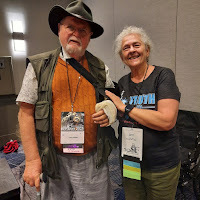 With Larry NivenSo I wentabout Friday evening and Saturday morning in finding my panelists, discussing thetopic, and not attending anyone else’s panels. I did, however, have a greattime catching up with my roommate and her wife, as well as checking out thedealers’ room, getting myself a decent breakfast (a challenge in itself), andholding many impromptu reunions in the hallways. Upon returning to ProgOps, Iwas told that yes, the panel was still on and a bunch of folks had checked “Attending”on the phone app, but no, it was not that panel. It was my other proposal,Finding Our Inner Guide to Political Action. Which I was very happy tohold forth on but felt I ought to give the other panelists a bit of advancewarning. In the process of tracking them all down again and enlisting anadditional person, I ran into Larry Niven in a hallway. I knew him slightly, asin in-passing, from many conventions over the years. I explained that the paneltopic had changed and he should not feel obliged to come if it wasn’t his areaof interest. He said he’d like to come.
With Larry NivenSo I wentabout Friday evening and Saturday morning in finding my panelists, discussing thetopic, and not attending anyone else’s panels. I did, however, have a greattime catching up with my roommate and her wife, as well as checking out thedealers’ room, getting myself a decent breakfast (a challenge in itself), andholding many impromptu reunions in the hallways. Upon returning to ProgOps, Iwas told that yes, the panel was still on and a bunch of folks had checked “Attending”on the phone app, but no, it was not that panel. It was my other proposal,Finding Our Inner Guide to Political Action. Which I was very happy tohold forth on but felt I ought to give the other panelists a bit of advancewarning. In the process of tracking them all down again and enlisting anadditional person, I ran into Larry Niven in a hallway. I knew him slightly, asin in-passing, from many conventions over the years. I explained that the paneltopic had changed and he should not feel obliged to come if it wasn’t his areaof interest. He said he’d like to come.By Saturdaynight, I’d advised all the panelists and done a bunch of preparation, the mostimportant being having a plan to keep the conversation slow enough so we couldlisten respectfully and deeply to one another (that’s the “inner guide” part)and avoid current political hot issues that could derail things. One panelistin particular had been concerned about a specific news item devolving into anargument. I said, “Do you trust me?” They agreed they did.
The panelitself was an inspiring experience for me (and for the panelists and audience,given their comments afterward). I asked for stories about times we’d takenaction, not because we were pressured into it but arising from a spontaneous innerprompting, an act of love. These ranged from the nonviolence practiced inaikido (a martial art in which force is turned into harmony) to Larry Niven’sstory about how he and other science fiction writers participated in NASAduring the Reagan era to my own story about how a single, impulsive email ledto statewide activism, writing for the blog of a national organization, andthen an invitation to an international conference. I loved the audiencefeedback, as authentic as the panelists’ stories.
After that, agreat Indian dinner my roommates arranged via Door Dash, and a night’s sleep, Igot to hang out with more friends and attend a great panel on collaboration inwriting. I’ve done this, both in-person and posthumously (the other author, notme!) so many of the issues were familiar to me, but it was a joy to relax andlisten. It didn’t hurt that one of my favorite authors, M. A. Carrick (MarieBrennan and Alyc Helms), were on the panel.
Note to self:next year, submit panel proposals early and bug ProgOps for a decision beforearriving at convention.
July 4, 2025
Audiobook Review: Judi Dench's Brilliant Shakespearean Career
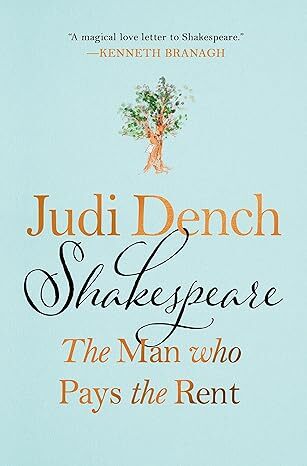 Shakespeare: The Man Who Pays the Rent, by Judi Dench and Brendan O'Hea; narrated by Barbara Flynn and Brendan O'Hea, with additional commentary by Judi Dench (Macmillan Audio)
Shakespeare: The Man Who Pays the Rent, by Judi Dench and Brendan O'Hea; narrated by Barbara Flynn and Brendan O'Hea, with additional commentary by Judi Dench (Macmillan Audio)This is a series of conversations between Judi Dench and her colleague, Brendan O'Hea, narrated by O'Hea and Barbara Flynn. Flynn does a marvelous job capturing the vocal qualities, cadence, and humor of Dench. I highly recommend listening to the audiobook.
Dench's long acting career began in 1957 with the Old Vic Company and later joined the Royal Shakespeare Company. Although most Americans know her work through film roles, she returned to the stage again and again. Over the decades, she acted almost every major female role in Shakespeare's plays. The book is structured around each of these plays, some well-known, others more obscure. Listening to her observations about each character, I was struck again and again by the depth of her emotional intelligence and keen insight. For example, the way she describes Lady Macbeth illuminated the personality and decisions of Macbeth himself in ways I'd never considered. Her observations about the structure of the plays and acting craft, such as the critical importance of what character's don't say, apply to prose narrative as well. It's wonderful to me how different forms of storytelling share the same principles.
Highly recommended.
June 27, 2025
Book Review: Alt-Wild West Meets Religious Cult
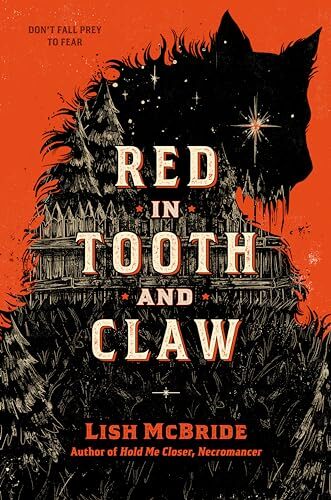
Red in Tooth and Claw, by Lish McBridge (Putnam)
Red in Tooth and Claw opens in an alt-Wild West setting that's close enough to historical to make the reader feel comfortable with conventions and expectations, yet just "off" enough to be creepy. Sensory descriptions and a truly marvelous POV character voice create a sympathetic protagonist (orphan Faolan, a girl masquerading as a boy whose grandfather guardian has just died) in a vivid, three-dimensional world. In a scheme to gain control of the grandfather's farm, the mayor concocts a scheme to ship Faolan off to "the Settlement" for their own good. Since Faolan is still a minor, she hasn't much choice. She stuffs the deed to the farm into her grandfather's watch, tucks the watch into the toe of an oversized boot, and pretends to be meekly obedient. I'm with her every step of the way at this point.
The Settlement is run by an eerily familiar-sounding cult that worships "the Shining God" and is run by the oily (as in snake-oil salesman) "HisBen" ("His Benevolence"). Despite their isolation, the Settlement is inordinately rich--behind its stockade, there's ample food, for example. Faolan is not the only kid who's been sent there to get them out of the way, and she soon makes friends and allies as well as enemies. She makes plans to escape, encounters a band of Rovers, falls in love, and gets catapulted into a horror mystery when people disappear and bodies appear. Something's out there, thirsting for blood.
For me, this is where the book loses the skillful evocation of the first part. The world is just enough askew from our own to make Faolan's predicament believable. When Faolan, who's finally gotten a decent meal when she arrives at the Settlement, thinks this place might not be so bad, I'm screaming, "Danger! Danger!" It's delicious, shivery stuff.
Then come the Rovers, who could have provided a counterpoint to the secretive Settlement leaders, with their bond with their horses and the natural world. But, and it's a huge but, the Rover culture is a slap-dash amalgam of generalized Native people cultures, Hollywood-style Roma, and Western Europeans. Many elements of their culture are poorly thought-out, often incongruous with each other. The Rovers, and especially Faolan's love interest, Tallis, lack the thoughtfulness and depth of the earlier settings.
By the time the monster makes an appearance through a trans-dimensional portal opened by HisBen's rituals, I was so disappointed, I no longer cared what happened. I knew that Faolan would get her very own sweetly tame monster, defeat HisBen, and live happily ever after with Tallis. (I was right.) What began as one type of story devolved into something quite inferior. I really, really wish the author had applied the same solid world-building and dramatic tension as in the opening to the rest of the book and not tried to switch genres.



